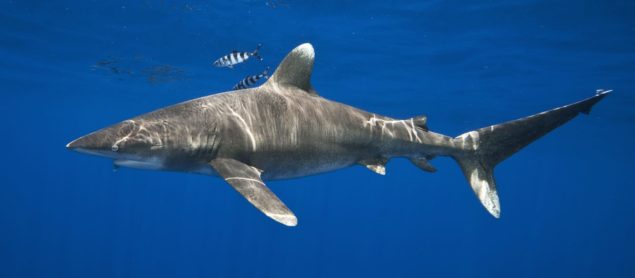The waters off the southern tip of Cat Island, Bahamas are one of the last remaining strongholds for oceanic whitetip sharks.
In the race to protect this once thriving, but now disappearing species, scientists are searching for the “pupping ground.” This is the place where sharks are born and spend the first few years of their life when they’re most vulnerable. Cat Island is where whitetips come to feed and breed. It’s not where they give birth. The pupping ground is elsewhere.
Getting to the bottom of this mystery is a matter of life or death for these enigmatic, elusive sharks. Once considered one of the most abundant shark species in the world, commercial fishing and the shark fin trade have decimated their numbers.
Earlier this year, oceanic whitetips were listed as threatened under the Endangered Species Act. As a part of the process to develop and implement a conservation plan, the National Oceanic and Atmospheric Administration convened a two-day recovery planning workshop, which was hosted at FIU’s Biscayne Bay Campus. FIU shark scientists Demian Chapman, Yannis Papastamatiou and Mark Bond were invited to share their expertise and begin developing recovery criteria for oceanic whitetips.
Residing in remote parts of the open ocean, oceanic whitetips are difficult to study. For nearly a decade, Chapman, Papastamatiou and Bond, have collaborated with a team of scientists in the Bahamas to find answers about the whitetips. They’ve tagged more than 100 sharks off Cat Island. The majority were female. And many were pregnant.
Tracking the tagged sharks’ movements, the team found the highly-migratory whitetips don’t move in any particular pattern. However, the majority of pregnant females all left the legally protected waters of the Bahamas — which has been a national shark sanctuary that prohibits shark fishing since 2011 — and headed into other, more dangerous waters. They all seemed to be convening in the same place: The Windward Passage, between Haiti and Cuba.
With this information, Bond began working with the Haiti Ocean Project, a nonprofit focused on marine conservation, education, research and ecotourism. He started by working with the biggest threat facing the young whitetips: Fishermen. Traveling to rural villages, Bond spoke with local fishing communities and shared what the Cat Island research team had learned. The goal was to make the fishermen a key part of saving the sharks. Many had seen or caught young whitetips. Few had ever saved one. But, as of today, they have rescued and released more than a dozen whitetips.
“These fishermen don’t know where their next meal is coming from, but they really want to help these sharks,” said Jamie Aquino, president and founder of the Haiti Ocean Project.
The relationships with the Haitian fishermen proved to be critical this summer when Bond was on a mission trip aboard OceanX’s research vessel Alucia to track down young whitetips in the Windward Passage.
The first few days of the expedition were a waiting game. Bond would begin his day at 5 a.m. — carving board, fish, knife and plastic buckets in hand. Then, he’d sit down to prepare the bait for the longlines, which would be lowered deep down into the ocean to attract the pups and juveniles.
The waters in Haiti were quiet. Almost too quiet. Sea birds and schools of fish — both signs of a health ocean ecosystem — were nowhere to be seen. And the whitetips weren’t biting.
Then, word came through that a local fisherman in Haiti had caught a juvenile. Bond and the researchers raced to him, tagged the shark and let it go. This was the first marine animal to be satellite tagged in Haitian waters. When the tag popped off two months later, it reappeared on southern side of Haiti where shark was originally tagged, revealing that the juveniles could be staying in this area.
While the expedition has ended, the work is just getting started. If anything, the mystery has intensified. Researchers are hoping to return to the region and use new technology to locate more juveniles.
In the meantime, local groups and fishermen in Haiti will continue to help reduce the number of young oceanic whitetips that are being killed. Bond believes it’s this grassroots emphasis that will help protect the oceanic whitetips at every stage of life.
“This is one of the only ways to implement lasting change in marine conservation, because we do need to consider the livelihood of the people that it would directly impact,” Bond said.






